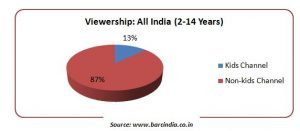Television Does More Harm Than Good To Kids: A Myth
A closely observed and repeatedly heard thing forces a child to deteriorate his interest in television. That is not the parents’ win over the child. That is a clear example of ‘letting lose your child what you cannot yourself replicate’. As parents and as teachers, we cannot create a high-quality Audio Visual data in order to augment learning in a manner that television does. With the set-up which it requires to create animations and characters make the child understand concepts and restore it for a longer period of time. Kids are usually seeped in with the thought of damaging their eyes if they watch TV for long hours. Who says? Where are the statistics? If you tell me that genetically or hormonally, the child is suffering of an eye disease or weakened eyes, it is a well-phrased thing and thus, easily digested. But I would look up for clear answers on the right amount of hours that a child spends with the ‘Education Box’ (the name I assign to the television). Key findings of various high valued platforms and agencies have made me conclude that it is a complete myth that television only harms. When valued critically, you will find it causing good than not so good.
One of the prominent statements comes from the American Academy of Ophthalmology (AAO). It says that kids can actually focus up close without eyestrain better than adults, so they often develop the habit of sitting right in front of the television or holding reading material close to their eyes. However, sitting close to a TV may be a sign of nearsightedness.
The reason is scientific and just clear to get into our senses. However, yes, I agree that the television time for kids should be well planned, observed and regulated. Rather than concentrating on demeaning television and bracketing it to a thing that cause only damages, we should peek into some statistics:
For a kid, watching television is like consuming media. They love and enjoy what they see because it is backened by strong graphics which is easy and clear to understand.
Kids do not generally have the tendency to incline towards Non-Kids or GEC (General Entertainment Channels) known by the famous names of Star, Sony, Zee etc. because the content lacks value which does not attract them towards its viewership. The clear indication here is that the major share on non-kids’ channel viewership is a result of Co-viewership that is kids watching such channels with family members and not of their own choice. The answer is very clear. We do not need to discourage TV viewing but channelize it towards channels based on pure infotainment. Some of the channels and programs (shows) which are either aired on TV or are available online are:
Tune in to these channels at times. Make your child watch and enjoy what these TV Shows want to teach them. A major problem here is we usually do not know that which channels are aired on our television sets and thus, tend to incline towards and watching GECs and kids have no choice to pool in that viewing. The problem is not watching TV. The problem is watching unrelated and wasteful content which will not benefit. If you tell your kids what to watch, they will know and better understand and relate to the content that is exclusively meant for them.
Please Note that some of the channels mentioned above are not aired round the year and you need to stay updated about the channels/programs featuring on TV. Television is a holder of dynamic content and keeps on updating. Despite this, the episodes and seasons of all the above channels and programs are available online.
Furthermore, Youtube channels should be subscribed to for kids’ learning and it is sure to cut down the television time and divert children towards online learning resources.
Most importantly, make your kids know and watch good stuff. Do not discourage television viewing but just divert them towards useful television content.




